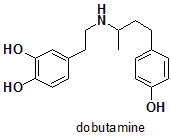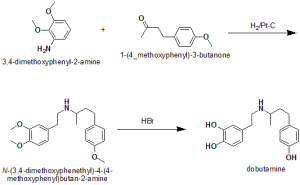DOBUTAMINE Synthesis, SAR, MCQ,Structure,Chemical Properties and Therapeutic Uses
Dobutamine
IUPAC nomenclature
(RS)-4-(2-{[4-(4-hydroxyphenyl)butan-2-yl]amino}ethyl)benzene-1,2-diol.

Classification
Dobutamiine is ß1-adrenergic agonist. [1]
Physiochemical Properties
| S. NO. | PHYSICAL AND CHEMICAL PROPERTIES | |
| 1 | Molecular weight | 301.4 g/mol |
| 2 | Physical appearance | Present in solid form |
| 3 | Melting point | 184-186°C |
| 4 | Solubility | Water solubility 0.0137 mg/mL |
| 5 | Octanol/water partition coefficient | 3.6 |
| 6 | Presence of ring | Benzene rings present |
| 7 | Number of chiral centers | 1 |
Mechanism of Action
Myocardial contractility and stroke volume of heart is increased by action of dobutamine on ß1-receptors of heart. This results in increased cardiac output.
Structure Activity Relationship
- Primary or secondary aliphatic amine separated by two carbons from a substituted benzene ring is essential for the high agonist activity.
- The hydroxyl substituted carbon must be in the R configuration for the maximal direct activity.
R1 substitution:
- When R1 is increased in size, activity of alpha receptors decreases and activity of the beta receptors increases
- Activity of both alpha and beta receptors is maximum when R1 is methyl group.
- Alpha agonist activity decreases when R1 is larger than methyl, and went negligible when R1 is isopropyl.
- Large lipophillic groups can afford compounds with alpha blocking activity.
- N-substituent provides selectivity for different receptors.
- Arylalkyl group can provide beta selectivity, increased cell penetration and increased lipophillicity for the longer duration of action.
R2 substitution:
- Ethyl group can eliminate the alpha activity of the drug.
- Erythrostero isomers have maximal activity.
- The additional methyl group makes the drug more selective for the alpha2
R3 substitution on the aromatic ring:
- 3’,4’-dihydroxy substituted benzene ring has poor oral activity.
- 3’, 5’-dihydroxy compounds are orally active.
- At least one of the groups is required which can form hydrogen bonds. And if only one group is present then it is preferred at 4’ position to retain the beta2
- If phenyl group has no phenolic substituent then it may act directly or indirectly.[2]
Method of synthesis
i. 3,4-dimethoxyphenyl-2-amine reacts with 1-(4-methoxyphenyl)-3-butanone followed by reduction togive an imine.
ii. Treatment with hydrogen bromide results in the cleavage of the methoxyl-protecting groups to give dobutamine.

Therapeutic Uses
The drug used for the treatment of:
- Acute and reversible heart failure
- Congestive heart failure
- Cardiac decompensation
Side Effects
The common side effects of dobutamine are hypertension, angina, arrhythmia and tachycardia.
MCQs
Q.1 Correct statements for the physicochemical properties of Dobutamine are?
I. Molecular weight is 251.5 g/mol
II. It is present in solid form at room temperature
III. Octanol/water partition coefficient is 3.6
IV. 2 chiral centers are present in its structure
a) I, III
b) II, IV
c) I, II, IV
d) II, III
Q.2 Match the following of the drugs with their correct IUPAC names.
| i. (RS)-4-(2-{[4-(4-hydroxyphenyl)butan-2-yl]amino}ethyl)benzene-1,2-diol | A. Dobutamine |
| ii. 4-(2-Aminoethyl)benzene-1,2-diol | B. Dopamine |
| iii. 3-(4,5-Dihydro-1H-imidazol-2-ylmethyl)-2,4-dimethyl-6-tert-butyl-phenol | C. Oximetazoline |
| iv. (R)-3-[-1-hydroxy-2-(methylamino)ethyl]phenol | D.Phenylephrine |
a) i-D, ii-A, iii-B, iv-C
b) i-B, ii-C, iii-A, iv-D
c) i-A, ii-B, iii-C, iv-D
d) i-C, ii-B, iii-A, iv-D
Q.3 Dobutamine produces its action through?
a) Agonism of ß-receptors of heart
b) Cell proliferation
c) Alkylation of the DNA
d) None of the above
Q.4 Correct sequence for True/false for the classification of the drug can be?
- Dobutamine: ß1-adrenergic agonist
- Phenoxybenzamine: Nonselective α-adrenergic antagonist
- Clonidine: Nonselective adrenergic agonist
- Dopamine: Mixed acting sympathomimetics
a) TTFF
b) FTFT
c) TFFF
d) FTFT
Q.5 When R1 of dobutamine is increased in size-
a) Activity of ß-receptors increases
b) Activity of α-receptors increases
c) Activity of ß-receptors decreases
d) Activity of α and ß receptors increases
Q.6 The correct sequence for the steps for synthesis of drug dobutamine from “ 3,4-dimethoxyphenyl-2-amine”?
I. Reaction with hydrogen bromide
II. Reaction with 1-(4-methoxyphenyl)-3-butanone
III. Reduction
a) I – II – III
b) III – I – II
c) I – III – II
d) II – III – I
Q.7 Which of the following is not a side effect of drug dobutamine?
a) Angina
b) Arrhythmia
c) Hypotension
d) Tachycardia
ANSWERS
1-a
2-c
3-a
4-a
5-a
6-d
7-c
REFERENCES
[1] Lemke TL, Zito SW, Roche VF, Williams DA. Essentials of Foye’s principles of medicinal chemistry. Wolters Kluwer; 2017, 340 [2] Lemke TL, Zito SW, Roche VF, Williams DA. Essentials of Foye’s principles of medicinal chemistry. Wolters Kluwer; 2017, 348-352